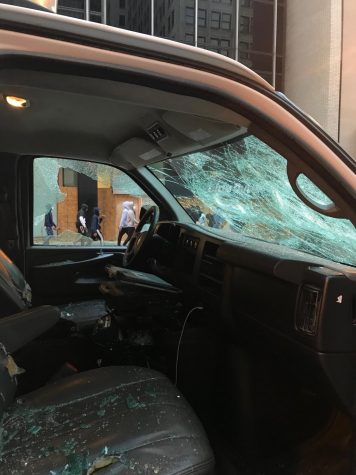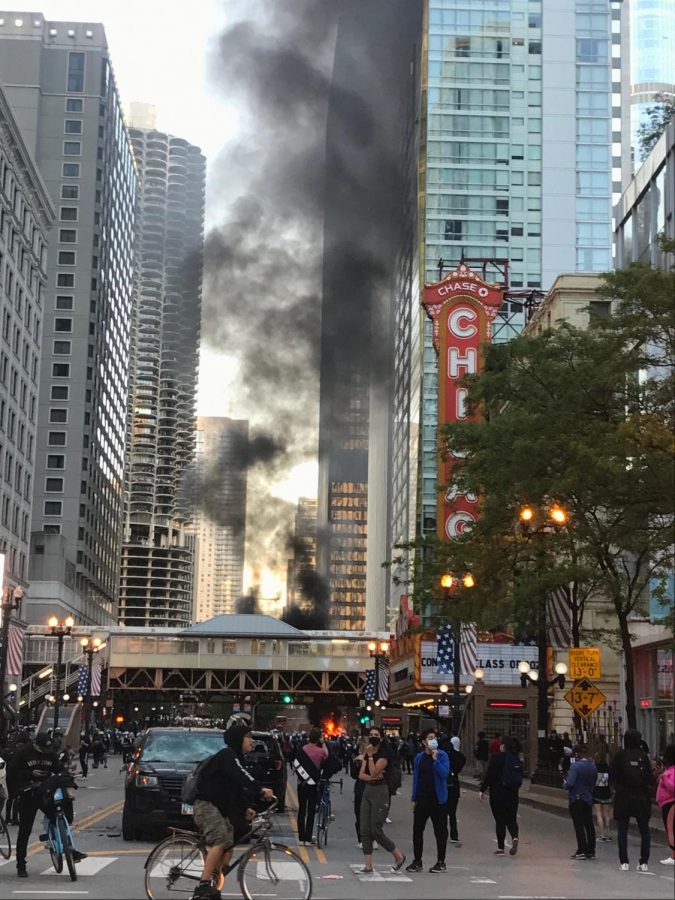A defense of illegal protests in the age of Black Lives Matter
It is time to recognize looting and destruction of property as forms of protest

More stories from Finley Williams
In the distance, smoke billows from a police cruiser set aflame by protesters in Downtown Chicago on May 30 during an evening of violent protests following the death of George Floyd.
The views expressed in this opinion article are those of the author and do not reflect the views of Lane Tech.
After a Louisville grand jury declined to indict any officers for charges directly related to the March police killing of a young Black woman, Breonna Taylor, politicians in Chicago — 300 miles away from Louisville — steeled for unrest.
In a Sept. 23 press conference that came hours after the ruling, Illinois Gov. J.B. Pritzker and Chicago Mayor Lori Lightfoot affirmed their disappointment with the grand jury’s decision, their commitment to racial justice and their desire that all Illinoisans protest peacefully.
“We have a choice to make in this city,” Lightfoot said, “and that is how we will respond to this news, how we will honor the legacy of Breonna Taylor. And my hope is that every one of us, regardless of what we feel about this verdict … no matter where we are in processing today’s news, we need to do so peacefully. Peacefully.”
Our politicians’ veneration of peaceful, legal protests — and dismissal of riots and looting as strictly opportunistic and apolitical — damages the Black lives matter movement. It is a form of respectability politics which communicates that those who do not demonstrate peacefully have made the wrong choice, as Lightfoot might say, and are not true protesters. It implies, further, that their grief is less honorable, less advanced and less deserving of respect. And from politicians who repeatedly voice their commitment to racial justice, but have taken precious few concrete steps toward that goal, it is almost hypocritical.
In the words of Candice Delmas, Assistant Professor of Philosophy and Political Science at Northeastern University, this stress on peaceful protests prostrates Black Americans, and “functions as a misplaced and disingenuous appeal to compliance in the face of black victimization. It valorizes docility and deters the population, especially blacks, from unruly kinds of resistance—and really, from any defiance at all.”
It is time, in short, for this nation to recognize that destruction of property and other sorts of illegality are forms of protest, and for politicians to stop drawing an arbitrary line between protest and illegality.
This is not to say that violence against property and other illegalities should be sanctioned or legalized, or are in the slightest bit palatable — rather, the exact opposite: legal demonstrations, demonstrations done with the consent of the governing body, are not protests; they are parades. A protest is an action that citizens take against the disposition of their government, not in conjunction with it. And it is a fallacy of logic for Lightfoot and Pritzker to energetically approve a protest, for if they were truly proponents of the advocated changes, the protest would not be necessary.
To Lightfoot and Pritzker, it seems that the purpose of dissent is merely to express dissatisfaction and solidarity; Lightfoot communicated this, at least, when she urged Chicagoans to partake in a citywide moment of silence instead of taking to the streets.
But the true aim of protest is to spur change. It is to scandalize, to apply pressure and to give politicians no choice but to respond to the will of the people. This, of course, is impossible when protesters operate within the methods prescribed to them by those in power.
It is then precisely because destruction of property and looting are painful — both emotionally and economically — that they are forms of protest.
At the Sept. 23 press conference, Pritzker admitted that he cannot know the pain of Black Americans who see themselves in the faces and fates of George Floyd, Jacob Blake, Breonna Taylor and countless others.
He continued, referencing a Louisville police officer’s lesser charge of reckless endangerment: “The pain of your government telling you that damaging a piece of property is a greater offense than taking a life.”
Later in the conference, Cook County Board President Toni Preckwinkle, in advocating for peaceful protests, said that protesters “cannot meet the violence of the police with violence of our own. It gives ammunition to those who do not share our concern for racial justice.”
The hypocrisy should be clear: Preckwinkle equates violence against property with violence against human life; she inflicts the exact pain of which Pritzker speaks by placing non-peaceful protesters and racist police officers on the same plane — as if breaking the window of a Target were as condemnable as shooting a Black woman while she slept.
Preckwinkle, moreover, plays a game of respectability politics, which holds that conforming to mainstream standards of behavior “will protect a person who is part of a marginalized group, especially a Black person, from prejudices and systemic injustices.”
The right way to protest, Preckwinkle implies, is one that the government finds acceptable, and that those who do not protest in that way are somehow fueling the opinions of those aloof from racial justice.
Lightfoot has even described looting at Black lives matter protests as “straight-up felony criminal conduct,” which unfairly and arbitrarily separates protesting from illegality, creating a false dichotomy between the two. The issue, I mean, is not that politicians condemn non-peaceful actions, but that they do not recognize them as protests.
I shuddered when, over the summer, I beheld a gallery of boarded Downtown storefronts, of graffitied sidewalks and broken windows — it was as if the city itself hid in fear. And this discomfort, this pain, this heartbreak that follows knowledge of tremendous injustice, is exactly the goal of a protest.

Politicians cannot disregard a razed city street the way they disregard peaceful chants. Politicians cannot ignore the screech of rage the way they ignore the prayer of sadness. Destruction of property is painful, and this is why it works as a way of protest, no less worthy than Dr. Martin Luther King Jr.’s March on Washington.
At bottom, any act that those in power condone is not protest — it is a high school talking circle, a meeting among like-minded friends which has no relevance to anyone else — and it most likely will not be effective. This is why even acts of peaceful but illegal resistance, like those of the Civil Rights Movement, number among the most effective in our nation’s history.
There is a reason why the most famous photographs of Rosa Parks, Malcolm X, Elijah Cummings and John Lewis are mugshots, and why the most famous moment in American revolutionary history was when the Sons of Liberty, young and determined, swept into Griffin’s Wharf and dumped 342 chests of tea into the harbor’s dark water.
They were breaking laws. They were making good trouble. They were acting for righteous causes in ways not at all accordant with the standards of those they protested against.
Why are these protests any different?
Your donations directly fund the Lane Tech student journalism program—covering essential costs like website hosting and technology not supported by our school or district. Your generosity empowers our student reporters to investigate, write, and publish impactful stories that matter to our school community.
This website is more than a publishing platform—it's an archive, a research tool, and a source of truth. Every dollar helps us preserve and grow this resource so future students can learn from and build on the work being done today.
Thank you for supporting the next generation of journalists at Lane Tech College Prep!

Naturally having harnessed the wisdom that comes with age, Finley, now a senior in her third year with The Champion (formerly The Warrior), spends her...

